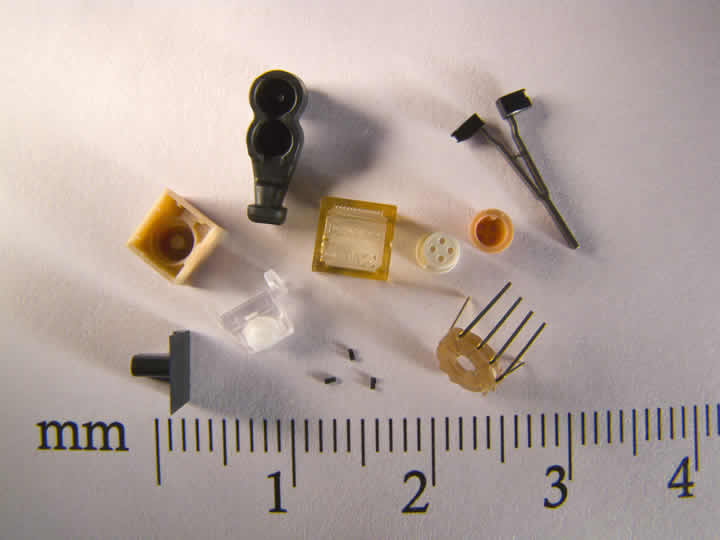OPTIMIZING OUTCOMES THROUGH MICRO MOLDING – AN EXPERT PERSPECTIVE

For companies that are exploring the possibilities that exist for miniaturization of plastic parts and components, there are some seemingly daunting obstacles that exist, not least the vagaries of the micro molding process itself. Molding at the micro scale renders redundant many of the “rules” associated with macro molding, and the process requires a completely new perspective in terms of such considerations as rheology, tooling, gating, and handling and assembly to name but a few.
Because of this, most OEMs that embark on a micro molding product development process engage with specialist micro molding experts that can navigate inherent issues, and through experience have honed the art of micro molding to optimise manufacturing outcomes. However, not all micro molding companies are the same, and in this Q&A interview, Craig Tappe, Sales Engineer at Accumold discusses various aspects of the micro molding process, and discusses why it is important to ensure that when short-listing your preferred suppliers, the correct questions are asked.
Q. What is design for micro molding (DfMM) and how does it play a crucial role in the success of micro molding project?
CT. DfMM refers to the process of developing and optimizing designs specifically tailored for micro-scale injection molding. Micro molding is a highly precise manufacturing technique used to produce miniature plastic parts with intricate details and dimensions in the micrometer range. Designing for micro molding involves considering factors such as material selection, part geometry, tooling requirements, and process limitations unique to micro-scale production. The goal is to create designs that maximize manufacturability, ensure part quality, and enhance functionality within the constraints of micro molding technology. Attention to detail, such as minimizing wall thickness variations, incorporating proper gating and venting, and addressing potential issues related to part ejection and moldability, is crucial in achieving successful micro molding outcomes.
DfMM is critical in the success of micro-molding because often the challenges of molding micro features require complex tool designs that test even the most experienced and well equipped toolrooms in the world. Accumold works upfront with customers to focus on thin-walled features, techniques for designing and molding undercuts, and material selection. Most of our customers don’t realize the extreme capabilities we have when it comes to feature sizes, thin walls, and feature definition on micro-molded parts, so we are happy to help.
Q. What are some of the challenges faced when transitioning from prototype development to large-scale production in micro molding? How does Accumold address these challenges effectively?
CT. Transitioning from prototype development to large-scale production in micro molding can present several challenges. One of the key difficulties is scaling up the production process while maintaining the same level of precision and quality achieved during prototyping. Factors such as material behavior, tooling design, and process parameters need to be carefully optimized to ensure consistent and reliable production. Additionally, issues related to cycle time, cooling, and part ejection become more critical when moving to large-scale production, as they can significantly impact productivity and cost efficiency. Managing the increased complexity of tooling, maintaining tight tolerances, and addressing potential defects or variations that may arise during high-volume manufacturing are also crucial challenges. Effective communication and collaboration between designers, engineers, and manufacturers become paramount in overcoming these hurdles and achieving successful large-scale production in micro molding.
Lots of times prototype molders will ask for part design changes that will eliminate micro features on parts as their tool maching processes are unable to achieve the required tolerances. Accumold produces hard steel prototype tooling with EDM machined cavity/core details to produce prototype parts with final production-like quality.
Q. In your experience, what are the key factors to consider when selecting a micro molding company that has the capacity to scale up to large-scale production? How does Accumold demonstrate this capability?
CT. When selecting a micro molding company with the capacity to scale up to large-scale production, several key factors should be considered. First and foremost, the company's expertise and experience in micro molding at larger volumes is vital. They should have a proven track record of successfully transitioning from prototype development to high-volume manufacturing. Additionally, the company's manufacturing capabilities, including advanced machinery, quality control processes, and ability to handle increased production demands, should be assessed. Effective project management, strong communication channels, and a commitment to continuous improvement are also important factors to ensure a smooth transition and sustained success in large-scale micro molding production.
More specifically, look for a large on-site toolroom that can handle multiple large projects at once, sustainability initiatives (recycling plastic), on-site automation team/capabilities to reduce cost, and open production floor space/press capacity to scale quickly. Accumold has everything I just listed.
Q. Can you provide examples of how Accumold has successfully managed to scale up from prototyping to large-scale production while maintaining quality and efficiency?
CT. The key requirements for a micro molding company to successfully scale up from prototyping to large-scale production while maintaining quality and efficiency include expertise in micro molding at larger volumes, advanced manufacturing capabilities, effective project management, strong communication channels, and a commitment to continuous improvement.
At Accumold, we’ve taken multiple projects for fortune 100 medical companies from the early engineering/DFM stages, into prototyping on 1-cavity tooling, then into full scale production with multiple 16 and 32 cavity tools. We currently run projects with 200 million part per year volumes and have capabilities/scalability to produce billions of parts per year.
Q. What are the advantages of vertical integration when micro molding? How does Accumold leverage vertical integration to enhance its capabilities and provide better value to customers?
CT. The advantages of vertical integration in micro molding include enhanced control over the entire production process, improved coordination between design and manufacturing stages, reduced lead times, better quality assurance, and increased cost efficiency. We vertically integrate our tooling, automation, processing, and quality systems at Accumold to provide a very logistically smooth and easy process for our customers. This vertical integration allows us to hold quick lead times and efficiently collaborate to solve problems and produce quality product.
Q. How does collaboration between design teams and micro molding experts facilitate the optimization of product design for the micro molding process? Can you share any success stories where this collaboration led to significant improvements?
CT. We work with customers to establish part designs that not only are ideal for the finished product, but also fit well with the molding process. This combination allows for a robust manufacturing solution and consistent part quality. We run mold flow simulations, provide feedback on snap features, work to provide solutions for molding complex undercuts, and share our expectations for finished part characteristics based off micro feature designs.
We worked with a wearable diabetes patch maker to redesign the cannula portion that is inserted into the patient’s skin that the insulin is dosed through. The old cannula design was an expensive multi step manufacturing process. It used a polyimide tube that had a tipping and flaring operation and a separate hub that this polyimide cannula was glued onto. These parts had lots of fallout and quality issues from the gluing and were very expensive. Accumold worked in our innovation lab to provide a solution for this problematic thin-walled drug delivery cannula. We were able to produce a single piece cannula that fit our customer’s design requirements and is produced at a fraction of the cost.
Q. What role does quality control play in micro molding, especially when scaling up production? How does Accumold maintain consistent quality throughout the entire manufacturing process?
CT. Quality is very important. We utilize automation wherever we can during the process to reduce human error. Some of our tool build processes use automation, our electrode cutting, electrode measurement, and touch off systems utilize automation to eliminate human error and ensure that every cavity from tool to tool are identical for high volume projects. The electrodes are used to EDM machine the fine core/cavity details into our mold steel. All our production cells use automation and most of our measurement techniques utilize automation as well. Accumold has strict preventative maintenance and calibration standards that are held on all equipment and tooling.
Q. How does Accumold stay up-to-date with the latest advancements and technologies in micro molding? Can you discuss any recent innovations that have significantly impacted Accumold's operations?
CT. We are constantly attending technology and equipment trade shows to ensure we have the latest and greatest equipment on the market. A year or two ago we brought in our first (we have two now) Nano Dimension Fabrica 2.0 micro additive manufacturing (AM) machines. This has helped us with rapid front end prototyping for low cost quick turn around front end development. We are now close to utilizing this technology for 3D printed prototype tooling. We plan to use a new high temp 3D printing resin to 3D print the mold core and cavity components for prototype tools.
Q. Can you provide insights into the future of micro molding, maybe changes in likely demand / applications? How is Accumold preparing for these anticipated changes?
CT. All components are getting smaller and multiple functions are being designed into each component. Wearable medical devices, micro-electronics, and surgical tools are just a few markets that components continue to get smaller and smaller. Accumold works to stay on top of and bring in new capabilities as soon as they are available. We also have an innovation lab specifically dedicated to providing solutions to challenging molding projects that we foresee potentially coming our way in the future.
Craig Tappe has been with Accumold for nearly eleven years, and has worked as a machinist, lead toolmaker, and is today one of the company’s sales engineers. Accumold has grown to a 130,000 square foot fortified facility designed for assurance of supply, employs over 350 staff, and is a net exporter shipping all over the world every day from its Ankeny, IA, USA facility which runs 24 hours a day, 7 days a week.
Comments (0)
This post does not have any comments. Be the first to leave a comment below.
Featured Product

